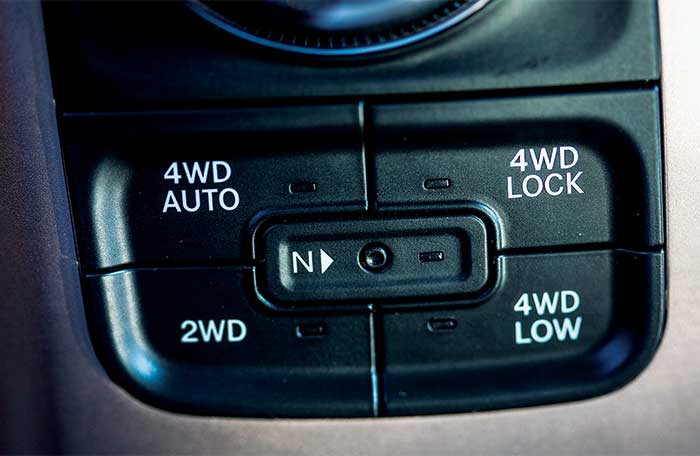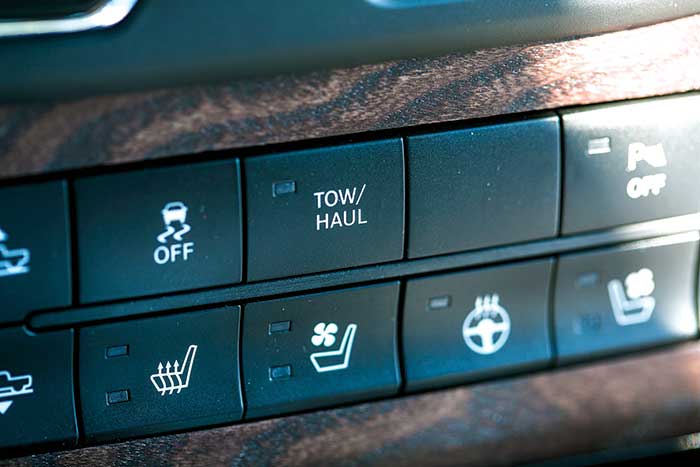Advertisement
Two-wheel, all-wheel, or four-wheel drive, it helps to know a little about each system and how it works.

Photo: Matthew Borkoski Photography
When considering a tow vehicle, what are the advantages and disadvantages of all-wheel drive (AWD) versus two-wheel drive (2WD) or four-wheel drive (4WD)? What makes AWD and 4WD different, and how does each system work for towing? At the end of the day, if all three systems are available on a tow vehicle you're considering, which should you choose?
Two-Wheel Drive
Two-wheel drive includes both rear-wheel drive (RWD) and front-wheel drive (FWD) systems. The most common and inexpensive drive systems are also the simplest. A shaft from the transmission drives a gear in the differential (or transaxle) that in turn drives two wheels (either front or rear). Front-wheel-drive vehicles generally have better performance in slippery or rough conditions than rear-wheel drive for two reasons: First, the engine and transmission are positioned directly over the front wheels, adding weight over the tires for better traction. Second, the wheels are pulling the vehicle along rather than pushing it, providing a better mechanical advantage.

Four-Wheel Drive
In a 4WD drivetrain, the output shaft from the transmission goes into a transfer case where the engine power splits between front and rear driveshafts. When the driver selects 2WD by moving a lever or turning a knob on the dash, the rear driveshaft turns a gear inside the rear differential that turns each wheel. When the driver selects 4H (high) or 4L (low), the front axle is also engaged, turning the front wheels. 4WD typically has to be manually engaged, so it's called a part-time 4WD system. There are some vehicles with permanent 4WD. This is a basic explanation of how 4WD works; it's actually a bit more complicated, especially now with computer-controlled 4WD systems. 4WD systems also have a dedicated transfer case with a separate low-range gear that multiplies the transmission gearing to provide for a much lower gear ratio, with the result being more power for each tire on wet or rough surfaces.


When the driver selects 4H (high) or 4L (low), the front axle is also engaged, turning the front wheels.
Some more expensive 4WD systems also offer AWD or 2WD settings. Usually, they operate in AWD or 2WD in normal operating conditions. In today's systems, computers constantly determine the optimum amount of traction the front and rear wheels need and adjust to deliver the engine's power accordingly. So, if one or more wheels are slipping, the computer automatically sends more power to the other wheels to compensate and aid the vehicle in maintaining control.
Traditional 4WD systems can add several hundred pounds and significantly reduce fuel economy. Other drawbacks include higher initial vehicle cost and added maintenance costs.
All-Wheel Drive
All-wheel drive is on-demand traction control that intermittently sends power to the non-primary-powered wheels. Most vehicles use a FWD system with an added differential inside the transmission or in a separate housing. AWD sends power through a shaft to a rear differential; power is then directed to each of the rear wheels. In some models, a certain percentage of engine power is sent to the rear wheels until the computer sensor detects front wheel slip and redirects more power.
Although this type of system doesn't offer an extra low-range gear, it does provide significantly better traction than FWD in slippery conditions because the AWD's computer system detects and compensates for wheel slip between front and rear wheels. The majority of AWD systems are not considered as capable as "true" 4WD systems. It's a common perception that AWD is not as hard-core as 4WD and should only be used for "all weather" driving, while 4WD can be used for "all condition" — including off road — driving. This is true to some extent, due in large part to the extra capability that the 4L gear selection gives 4WD systems — a feature that AWD systems do not offer.
How Do I Know Which To Choose?
Start With Using A Ramp
Our advice is that if you are going to use your vehicle for towing, AWD is the minimum you should consider. Launch ramps should be a major factor in pushing your choice toward AWD or 4WD. A 2WD vehicle, especially a RWD model, is simply not going to be as effective in pulling a boat out of the water at a steep or slippery ramp. On the road, especially at highway speeds in the rain, AWD offers a measure of security and traction that 2WD cannot.
Work The System
Choose the system that best suits your needs depending on the amount of towing and the size of your towed load, as well as the types of launch ramps you will encounter. For most recreational towing, AWD is the best choice. For heavy-duty towing (anything over 5,000 pounds), a full-size pickup or SUV is going to be the only logical choice, anyway, and these generally come with a 4WD option.
Worth The Dough?
For those who say AWD or 4WD is an added expense you'll never use, ignore them. If you use it once to keep from getting stuck on the ramp or get out of tough conditions on a snowy road, you'll be thankful you didn't cheap out.
